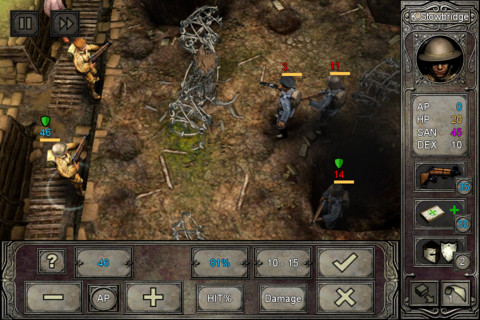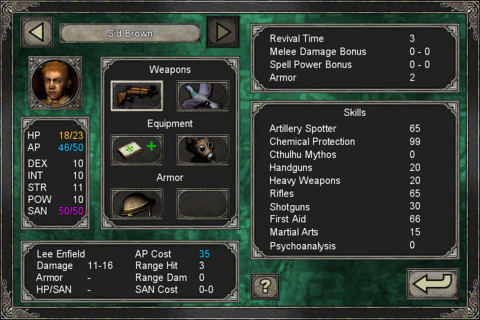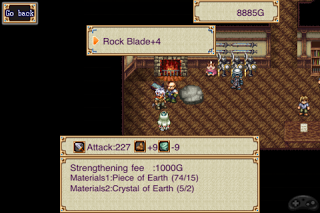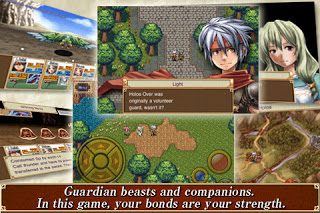Cardinal Quest [Joshua E Day] – $1.99
Number of Results: 19

For a Turn Based Strategy game to work, it has to have quality controls and a workable interface. In ‘Call of Cthulu’, the controls work solidly, though they feel somewhat unintuitive at times. To move your character, you tap on them and then tap the place you want to go. Attacking requires you to select your character then tap and hold on the enemy you want to shoot at. These mechanics work fairly well, though will occasionally not do exactly what you to (i.e. it will infrequently take several tries for a tap to be recognized). One minor annoyance with the mechanics is that you can’t move around or select anything else while your character is in motion; you have to wait for the character to get all the way there and stop to select another character. This is only really annoying when you have to move your characters over a longer distance. The only glaring problem with the controls, however, is that when you accidentally make a mistake or realize you went too far, there’s no undo button available. Any minor control pains and nuances could be heavily alleviated and eased with this addition. Especially with the importance of action points, even the smallest mistake can feel brutal. Other than that fact, the controls usually work very well and feel solid enough. There are also several options like rotating the field of play that can make the game feel more intuitive. The interface feels fairly good as well, albeit a little bit scary to inexperienced players. Especially on the character screen, the sheer number of skills and numbers can leave the player confused and uncertain of what to do. However, that’s not necessarily a bad thing, as most of the skills are easy to understand, albeit a bit difficult to interpret their usage in-game. Though they work decently for the game, the controls and interface still have some room for improvement.

The graphics in the game look fairly nice. However at times, the graphics do appear a little on the blurry side; even on retina-enabled devices they don’t look perfect. However, they do get the job accomplished and feel particularly fitting for the game. Some graphical effects like smoke and twitching makes the game feel more vivid and real, even at times when the game is stalled. The music and sound effects fit the game very nicely as well. The music feels very ghostly and somewhat sinister, with thunder and thumps in the background. Sound effects are as they’d be expected to be, with nothing really out of the ordinary. The music to the game leaves little to be desired, but the graphics do have a small margin for improvement.


The moment we have all been waiting for has arrived. The thrilling aspects of an Action RPG and the genius behind real-time strategies have been combined into one awesome game. Surely, you have heard of the massively popular free-to-play computer game, League of Legends. With LoL, Riot Games not only championed the free-to-play structure but also built on the “battle arena” gameplay of DoTA. In Legendary Heroes, Maya Games has brought this same gameplay and a somewhat similar monetary structure onto the iDevices. This game does not disappoint.
If you are not familiar with games like DoTA or League of Legends, here is what you need to know about the style of gameplay. In Legendary Heroes you have 3 heroes on your team. You can control each of them (1 at a time) and the other 2 will be AI when not in your control. The goal of the game is to protect your “source” or base, and destroy the other team’s source. Before you do this, you have to destroy all of the other team’s towers. To help you do this, these little guys called “minions” are automatically spawned and pretty much charge the other team and fight to the death. There is quite a bit of strategy involved if you actually want to do well. For example, you don’t want to sprint ahead of your minions and go tank one of the towers. More often than not you will be left with a minuscule amount of health and will be easy prey for the enemy.
If you have ever played a game like DoTA or LoL, you are probably thinking to yourself, ‘How the hell did they take into consideration the fact that you are constantly clicking your mouse to move your hero?’ Sure, you could just translate the mouse clicks into screen taps and tap-away at the screen to move your hero, but the controls let you drag your finger around to move your hero. This works very well and it gives you pretty solid maneuvering skills. One thing to not is that screen space is very limited on the iDevices. In Legendary Heroes the on-screen UI is minimal so you won’t need to worry about having a cluttered screen. While playing a round, you have access to a mini-map that shows where you and your teammates are (fellow heroes and minions) along with where your enemies are, as well as a few skill boxes and your hero info. The way this is all set up makes it very accessible and above all comfortable to play.
In terms of the Free-to-play structure, Maya Games has done an excellent job of keeping it balanced and reasonable. It’s always good to have options, especially when it comes to IAP’s on iOS. It has become apparent from previous games that if there isn’t some alternative to the IAP’s many people will be infuriated beyond reason. It’s safe to say that in Legendary Heroes the IAP’s are in no way necessary. Basically, there are two types of currency, gold and crystals. Gold is gained by completing a mission, and crystals are gained by accomplishing all of the tasks/goals withing a mission. The currency is used to unlock power-ups and heroes. In total, there are 32 power-ups and 8 heroes to unlock. Of course, time is the only thing standing between you and the unlocks, and if you want to speed things up you can choose to stock up on the currency through IAP’s.
An important thing to note is that power-ups and skills are not the same. While you play the game, your heroes will level up. Killing enemies and enemy structures will give you experience. When you level up, you get points that can be used to upgrade your hero’s skills. Each hero has 4 unique skills ranging from leap-attacks to teleportation. These skills are one of the keys to success in a mission. On the other hand, power-ups have temporary effects like extra health, bonus attack power, or more speed. These must be purchased each time before a round and are one-time uses. If you are confused about the power-ups just think about them like health potions. When you use them once, they are gone.
Maya Studios has taken the successful gameplay and free-to-play structure of League of Legends and essentially “ported” it over to iOS. The fact that they were able to make it flow so well on the small touch screen is nothing short of amazing. Of course the game is not perfect, and the lack of a multi-player mode could make or break its success. Future updates are on the way with new heroes and hopefully new game modes. At the price of free, there is no reason not to pick Legendary Heroes up today and try it for yourself.
| Get it on iTunes: Legendary Heroes |